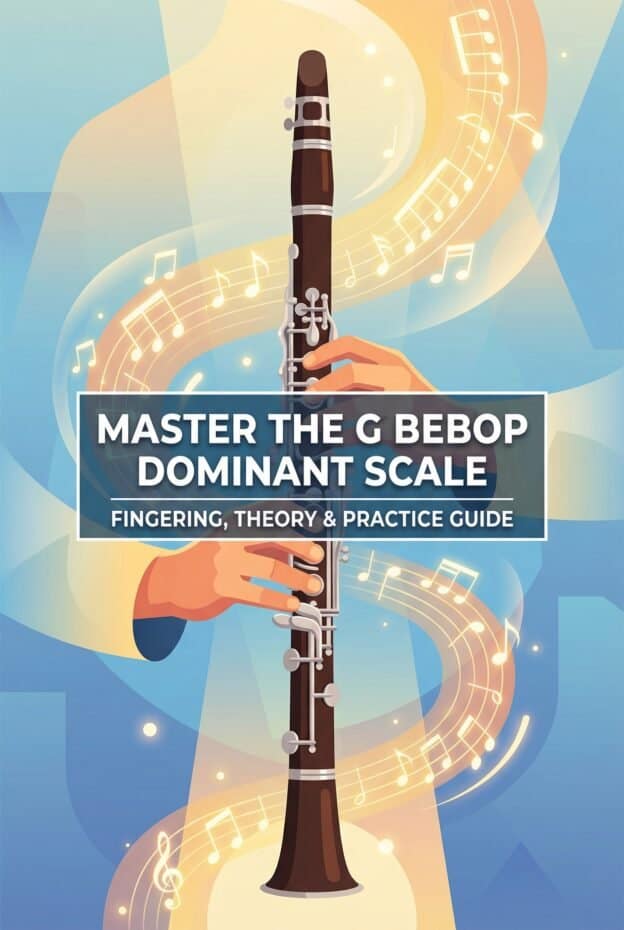G Bebop Dominant Scale (clarinet fingering): G A B C D E F F# G. On Bb clarinet this sounds as F bebop dominant. Use the added F as a chromatic passing tone between E and F# to keep steady eighth-note flow in bebop lines. A free downloadable fingering chart PDF for Bb clarinet is included below.
What is the G Bebop Dominant Scale?
The G Bebop Dominant Scale is an eight-note version of the G Mixolydian scale used in bebop improvisation. The notes are G A B C D E F F# G. That added F creates a chromatic passing tone that lets you play continuous eighth notes while still landing chord tones on strong beats over a G7 chord.
On clarinet, this scale is especially useful for soloing over tunes in the key of C major where G7 is the dominant chord. Jazz clarinetists use this pattern to outline G7, create forward motion, and connect arpeggios smoothly. The extra note is what gives the line a classic bebop sound and rhythmic stability.
For clarinet students, the G Bebop Dominant Scale is a gateway into bebop language. It connects theory, finger coordination, and real improvisation. Once you master this one key, you can transpose the pattern to any dominant chord and use it across standards, etudes, and solos.
Quick Fingering Chart: Free Download (Clarinet PDF)
For Bb clarinet, written G Bebop Dominant Scale fingerings are straightforward, but the chromatic E-F-F# section can feel awkward at speed. A clear fingering chart helps you visualize the pattern and choose efficient options for both lower and upper registers.
The free PDF fingering chart includes:
- Written G Bebop Dominant Scale ascending and descending (Bb clarinet)
- Lower register fingerings from low G to throat A
- Upper register fingerings from clarion G to high C
- Suggested alternate fingerings for F and F# to smooth chromatic runs
The chart is formatted for printing on a single page so you can keep it in your practice folder or band binder. Teachers can photocopy it for studio use, and band directors can share it with jazz ensemble clarinetists.
Download the PDF, place it on your stand, and play slowly through each octave. Mark any fingerings that feel best for your hand. Over time, you will memorize the pattern and only refer back to the chart when you explore new keys or registers.
G Bebop Dominant Scale: Notes, Structure, and Theory
The G Bebop Dominant Scale comes from the G Mixolydian mode, which fits naturally over a G7 chord. G Mixolydian is G A B C D E F G. To create the bebop dominant version, you add the major seventh (F#) between F and G, but in this case we keep both F and F# between E and G.
So the full scale is: G A B C D E F F# G. In scale degree terms relative to G7: 1 2 3 4 5 6 b7 7 1. That b7 to 7 motion (F to F#) creates a strong pull into the root or third, which is why it feels so melodic in bebop lines over G7.
Rhythmically, the eight-note structure is the key. When you start the scale on a chord tone (like G or B) on a downbeat and play straight eighth notes, the chord tones keep landing on strong beats. The F (b7) usually falls on a weak beat, so it acts as a passing tone that does not clash with the harmony.
On clarinet, you can think of the G Bebop Dominant Scale as a Mixolydian scale with a built-in chromatic connector. That connector lets you weave in and out of arpeggios while maintaining a steady flow. It also makes it easier to outline guide tones like B and F over ii-V-I progressions in C major.
Once you understand the structure on G7, you can move the same pattern to any dominant chord: simply build a Mixolydian scale on the root, then add the major seventh as a chromatic passing tone. The clarinet fingerings will change, but the theory and bebop function remain identical.
Transposition & Which Clarinet Are You Using? (Bb vs A vs Bass)
Most jazz clarinetists use a Bb clarinet, so written G actually sounds as concert F. That means when you play the written G Bebop Dominant Scale on Bb clarinet, you are producing the F Bebop Dominant Scale in concert pitch. For playing with concert pitch instruments, keep this transposition in mind.
On A clarinet, written G sounds as concert E. So the same written fingering pattern will function as an E Bebop Dominant Scale in concert pitch. This can be useful if you are playing in sharp keys or reading parts originally written for other instruments in a chamber jazz setting.
Bass clarinet in Bb follows the same transposition as soprano Bb clarinet: written G sounds as concert F, just an octave lower. The fingerings are essentially identical, but the response and resistance feel different. You may need to adjust air support and articulation for fast bebop passages on bass clarinet.
When practicing with play-along tracks or piano, remember:
- To solo over concert G7, play written A7 Bebop Dominant on Bb clarinet.
- To solo over concert F7, play written G7 Bebop Dominant on Bb clarinet.
- To solo over concert C7, play written D7 Bebop Dominant on Bb clarinet.
Clarinetists who double on saxophone should also remember that sax transpositions differ. Alto and baritone are in Eb, while tenor and soprano are in Bb. Keeping a simple chart of concert to written dominant chords can prevent confusion when switching between instruments in a jazz ensemble.
Clarinet-Specific Fingering Tips and Instrument Anatomy Notes
The clarinet's cylindrical bore and register key system create a large break between throat A and clarion B. When playing the G Bebop Dominant Scale, you will often cross this break, especially in two-octave patterns. Smooth finger coordination at the break is important for clean bebop lines.
In the lower register, G A B C D E F F# G uses mostly simple fingerings. The tricky part is the E-F-F# sequence. E uses six fingers of the left and right hand. F adds the right-hand E/B key. F# can be played with the right-hand F#/C# key or with the side key, depending on your hand size and speed needs.
In the upper register, clarion G A B C D E F F# G involves more complex keywork. The F and F# options multiply: you can use long F, forked F, or thumb F, and for F# you can use the standard F#/C# key or side F#. Each option changes the balance of the hand and the smoothness of the chromatic connection.
Here is a practical breakdown for the E-F-F# segment in the staff:
- E: standard E (left-hand 1-2-3, right-hand 1-2-3, no side keys)
- F: add right-hand E/B key (standard F)
- F#: keep E fingers, add right-hand F#/C# key, or slide to side F# key
In the clarion register, for A-B-C-D-E-F-F#-G patterns, experiment with:
- Long F (left-hand 1-2-3, right-hand 1-2-3, plus right-hand F key)
- Forked F (left-hand 1-2-3, right-hand 1-3, plus right-hand F key if needed for tuning)
- Thumb F (using the left-hand thumb key plus specific combinations, depending on your clarinet model)
The clarinet's throat tones (G, G#, A, Bb) can also appear in bebop lines when you extend the G Bebop Dominant Scale downward. These notes often sound weaker, so use firm air support and consider resonance fingerings, such as adding right-hand fingers to stabilize throat A or Bb in fast passages.
Understanding which holes and keys are actually opening or closing helps you choose fingerings that minimize motion. Watch your fingers in a mirror as you play the scale slowly. Any extra lifting or twisting will cost you speed when you push the tempo into true bebop territory.
How to Practice the G Bebop Dominant Scale – Exercises & Etudes
Effective practice of the G Bebop Dominant Scale on clarinet starts with slow, controlled repetition. Begin with a single octave in quarter notes at a comfortable tempo, such as quarter note equals 60. Focus on even tone, clean finger motion, and clear articulation on each note, especially around E-F-F#.
Once the basic shape feels secure, move to eighth notes. Still at 60 bpm, play ascending and descending patterns, slurred and then tongued. Aim for a legato connection between notes, with the tongue simply starting each sound. Avoid heavy accents that break the bebop flow unless you are practicing specific phrasing.
Next, add rhythmic variations:
- Triplet groupings that still use the bebop scale notes
- Accent every third or fourth note while keeping the line legato
- Start on different scale degrees, such as B or D, and still land chord tones on downbeats
Create simple etudes by limiting yourself to the G Bebop Dominant Scale over a static G7 drone or backing track. Write out 4-bar phrases that ascend, descend, and change direction. Include arpeggio fragments like G-B-D-F and approach them with chromatic neighbors from the scale.
As you progress, set tempo goals:
- Week 1-2: 1 octave at 60 bpm in eighth notes, then 80 bpm
- Week 3-4: 2 octaves at 100 bpm in eighth notes, tongued and slurred
- Week 5-8: 2 octaves at 140-200 bpm in eighth notes for authentic bebop speed
Record yourself regularly. Listen for uneven spots, especially at the register break and in the E-F-F# area. If one segment sounds messy, isolate just those three or four notes and loop them in short bursts. Then reinsert them into the full scale at a slightly slower tempo.
Applying the Scale to Improvisation: Licks, Lines, and Voice-Leading
Once the G Bebop Dominant Scale feels comfortable under your fingers, the real payoff comes from using it in improvisation. Start by practicing simple licks that outline G7, then connect them to ii-V-I progressions in C major, such as Dm7-G7-Cmaj7. Focus on targeting chord tones on strong beats.
Here are a few conceptual lick ideas using the G Bebop Dominant Scale on clarinet:
- Ascending line: G A B C D E F F# G, then resolve to E on Cmaj7
- Descending enclosure: B A G F F# G, then down to D on Dm7
- Arpeggio with approach: F F# G B D C B A G, landing B on a strong beat
Voice-leading is central to bebop sound. Use the scale to connect the 3rd of Dm7 (F) to the 3rd of G7 (B) and then to the 3rd of Cmaj7 (E). The chromatic F to F# to G motion in the G Bebop Dominant Scale helps you create smooth lines that lead naturally into resolutions.
Practice over backing tracks that loop ii-V-I in C. Limit yourself to:
- Dm7: D Dorian or arpeggio-based ideas
- G7: G Bebop Dominant Scale only
- Cmaj7: C major or C major bebop patterns
As you gain confidence, create 8 short bebop licks using only the G Bebop Dominant Scale over G7. Write them down, then transpose them to other keys. This process helps you internalize the sound so it becomes instinctive during real-time improvisation on clarinet.
Historical Context: Bebop Era and Clarinetists (Buddy DeFranco, Jimmy Giuffre, Benny Goodman legacy)
The bebop era emerged in the early to mid-1940s, centered around New York musicians like Charlie Parker and Dizzy Gillespie. Their fast, harmonically rich lines pushed beyond swing-era vocabulary. The bebop dominant scale concept grew out of their need for continuous eighth-note lines that still respected chord tones on strong beats.
Clarinetists adapted to this new language in different ways. Buddy DeFranco was a leading bebop clarinet voice, bringing Parker-like fluency to the instrument. On recordings from the late 1940s and 1950s, such as his work with the Metronome All-Stars and his small group sessions, you can hear extended dominant lines that reflect bebop dominant patterns.
Jimmy Giuffre explored a more cool and experimental approach, but his lines also show chromatic embellishment of dominant chords. On recordings from the early 1950s, he often used passing tones and approach notes around chord tones, a concept closely related to bebop dominant scales, even if not labeled that way in theory texts.
Benny Goodman, though primarily associated with swing, was aware of bebop developments. Later in his career, some of his small group performances show more modern harmonic approaches. While he did not fully embrace bebop language like DeFranco, his legacy set a technical standard that made bebop-level articulation and speed on clarinet possible.
Interviews in publications such as DownBeat and JazzTimes have documented how postwar clarinetists studied saxophonists' bebop lines and adapted them to clarinet. The bebop dominant scale became one of the tools for translating that language, especially for players who wanted to maintain the clarinet's distinct tone while speaking a modern harmonic dialect.
Musicological sources like Grove Music Online discuss bebop's impact on harmonic practice, including the use of chromatic passing tones over dominant chords. The G Bebop Dominant Scale is a practical clarinetist's version of that broader harmonic shift, distilled into a single, playable pattern.
Maintenance & Setup Tips That Help Execute Fast Bebop Lines
Fast bebop lines expose every weakness in your clarinet setup. A good reed, responsive keywork, and a stable mouthpiece make the G Bebop Dominant Scale much easier to play cleanly at high tempos. Before chasing speed, make sure your equipment supports your technique.
Reed selection is important. For most intermediate to advanced clarinetists, a strength between 2.5 and 3.5 works well for bebop articulation. Softer reeds respond quickly but can sound thin or unstable; harder reeds offer more core but require stronger embouchure and air. Rotate at least 3-4 reeds to keep your setup consistent.
Mouthpiece choice also matters. A medium facing with a balanced tip opening usually offers the best mix of control and flexibility. Extremely open mouthpieces can make fast articulation tiring, while very closed ones can feel stuffy. Work with your teacher or technician to find a mouthpiece that lets you tongue lightly and still project.
Key maintenance affects chromatic fingerings. Sticky pads on F, F#, or throat keys will ruin fast bebop passages. Have a technician check pad seating, spring tension, and key alignment at least once a year if you practice regularly. A small amount of key oil on pivot screws, applied by a professional, keeps action smooth.
Use a short pre-practice checklist before working on the G Bebop Dominant Scale:
- Check reed: no chips, warps, or soft spots
- Swab the bore to remove moisture and dust
- Test F and F# keys for quick response
- Play long tones on G, B, D, F to center intonation
- Warm up with slow chromatic scales around E-F-F#
A regular tuning regimen, including checking with a tuner on G, B, D, and F, helps you hear when bebop passing tones are in tune relative to chord tones. This ear awareness lets you use the added F and F# in the G Bebop Dominant Scale without sounding harsh or out of place.
Troubleshooting Common Problems When Playing Bebop Lines
When clarinetists first tackle the G Bebop Dominant Scale at bebop tempos, several common problems appear. Identifying the issue quickly and applying a targeted fix saves practice time and prevents frustration. Use a simple diagnostic approach: if you get X, try Y.
If you get squeaks at the register break, especially moving from throat A to clarion B in extended bebop lines, check your voicing and finger timing. Keep the tongue high in the mouth, as if saying “ee,” and ensure that the left-hand index finger and register key move together. Practice slow slurs over the break before adding speed.
If F or F# sound out of tune or unstable, experiment with alternate fingerings. For example, in the clarion register, try forked F with added right-hand fingers for stability, or use side F# instead of long F# in fast passages. Check each option with a tuner and choose the one that balances intonation and speed.
If articulation feels sluggish on fast eighth notes, lighten the tongue and increase air speed. Think of the tongue as touching the reed very briefly, almost like a feather. Practice double-tonguing only after your single-tongue is clean at moderate tempos. Short articulation drills on repeated G or B notes can build speed without complex finger motion.
If the E-F-F# segment sounds uneven, isolate those three notes. Play them in rhythmic patterns such as triplets or dotted rhythms. Focus on keeping fingers close to the keys and minimizing unnecessary motion. Then reinsert that segment into the full G Bebop Dominant Scale at a slightly slower tempo.
If your lines sound mechanical, not musical, work on phrasing. Add dynamics, small accents on chord tones, and breath shapes that rise and fall across phrases. Sing your bebop lines away from the clarinet, then try to match that vocal phrasing with your instrument using the same G Bebop Dominant Scale notes.
Notable Recordings and Archive References
While few recordings explicitly label their lines as “bebop dominant scale” examples, many classic jazz clarinet solos use similar chromatic dominant patterns. Listening closely helps you internalize the sound and apply it to your own G Bebop Dominant Scale work on clarinet.
Buddy DeFranco's recordings from the late 1940s and 1950s are important. On small group sessions like “Buddy DeFranco and Oscar Peterson Play George Gershwin” (1954), you can hear rapid dominant lines that outline chord tones with chromatic passing notes. Transcribing short phrases reveals bebop dominant-like motion over G7 and related chords.
Jimmy Giuffre's work with the Jimmy Giuffre 3 in the late 1950s shows a subtler use of chromatic dominant lines. While his style leans toward cool jazz and chamber textures, his clarinet solos often use passing tones around dominant chords that resemble bebop dominant patterns, especially in transitional phrases.
Archival interviews in magazines such as DownBeat and JazzTimes document how these clarinetists studied saxophonists like Charlie Parker and Sonny Stitt. They adapted saxophone bebop vocabulary, including dominant scale patterns, to clarinet fingerings and tone. This historical link explains why the G Bebop Dominant Scale feels so natural in modern clarinet improvisation.
Music reference sources like Grove Music Online and jazz history texts discuss the broader harmonic language of bebop, including the use of chromaticism over dominant chords. While they may not always name the G Bebop Dominant Scale specifically, the theoretical concepts align closely with what clarinetists practice today.
Further Resources, Internal Links, and Downloadables
To deepen your work with the G Bebop Dominant Scale on clarinet, combine written materials, recordings, and structured practice plans. Start with the downloadable fingering chart PDF for Bb clarinet, which shows the full two-octave pattern, alternate fingerings, and suggested practice rhythms.
Supplement the chart with printed or digital etudes that focus on dominant chord lines. Many jazz method books include bebop-style studies that can be adapted for clarinet. When you encounter a G7 passage, consciously apply the G Bebop Dominant Scale pattern and mark it in your music.
Use play-along tracks or backing apps that let you loop G7 or ii-V-I in C. Set tempos from 60 to 200 bpm and track your progress over several weeks. Aim to reach a point where the G Bebop Dominant Scale feels as natural as a simple major scale under your fingers.
Teachers and band directors can share the PDF chart with students and assign specific measurable goals, such as playing the scale in two octaves at a given tempo or composing short bebop licks. This structured approach helps students move from theory to real musical outcomes on the clarinet.
Key Takeaways
- The G Bebop Dominant Scale on clarinet is G A B C D E F F# G, an 8-note Mixolydian-based pattern that keeps chord tones on strong beats.
- Clarinet-specific fingerings around E-F-F# and the register break are important for clean, fast bebop lines.
- Consistent maintenance, smart practice plans, and listening to bebop clarinetists help you turn this scale into real improvisational vocabulary.
FAQ
What is G Bebop Dominant Scale?
The G Bebop Dominant Scale is an 8-note version of the G Mixolydian scale used over G7 chords. Its notes are G A B C D E F F# G. The added F acts as a chromatic passing tone that lets you play continuous eighth notes while still landing chord tones on strong beats.
How do I finger the G Bebop Dominant Scale on a Bb clarinet?
On Bb clarinet, written G Bebop Dominant uses standard G A B C D E fingerings, then F with the right-hand E/B key, and F# with the right-hand F#/C# or side key, followed by G. In the clarion register, use appropriate long or forked F and F# options. A detailed PDF fingering chart helps you choose the best combinations.
When should I use the added F# in the G bebop dominant scale?
The added F# appears between F and G and functions as the major seventh of G7. Use it as a passing or approach tone that leads into G or B on strong beats. In practice, you can run E-F-F#-G in eighth notes, letting F fall on a weak beat and F# pull strongly into a chord tone.
Can I use this scale over other chords besides G7?
Yes. The G Bebop Dominant Scale fits best over G7 or G9 type chords, especially in ii-V-I progressions in C major. You can also use it over related chords that function as V of C, such as G7alt with some care. To use the same concept on other dominants, build a bebop dominant scale on each new root.
Where can I find recordings that demonstrate the G Bebop Dominant sound?
Listen to bebop and post-bop clarinetists like Buddy DeFranco and Jimmy Giuffre. Their solos over dominant chords often use chromatic passing tones similar to the G Bebop Dominant Scale. Transcribing short phrases from their recordings and analyzing the dominant lines will help you hear and apply the sound on your own clarinet.







